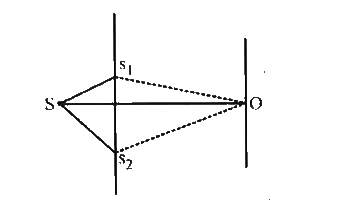Assertion (A) : The fringe obtained at the centre of screen in known as zeroth order fringe, or the central fringe
Reason (R ) : Path difference between the waves from S1 and S2 , reaching the central fringe (or zero order fringe) is zero
Both 'A' and 'R' are true and 'R' is the correct explanation of 'A'
Both 'A' and 'R' are true and 'R' is not the correct explanation of 'A'
A' is true and 'R' is false
A' is false and 'R' is true
The correct Answer is:A
Step by step video, text & image solution for Assertion (A) : The fringe obtained at the centre of screen in known as zeroth order fringe, or the central fringe Reason (R ) : Path difference between the waves from S_(1) and S_(2) , reaching the central fringe (or zero order fringe) is zero by Physics experts to help you in doubts & scoring excellent marks in Class 12 exams.
Topper's Solved these Questions
- BOOK - NARAYNACHAPTER - WAVE OPTICSEXERCISE - LEVEL - I (C.W)38videos
WAVE OPTICS
- BOOK - NARAYNACHAPTER - WAVE OPTICSEXERCISE - LEVEL - II (C.W)31videos
WAVE OPTICS
- BOOK - NARAYNACHAPTER - SEMICONDUCTOR ELECTRONICSEXERCISE - ADDITIONAL EXERCISE (ASSERTION AND REASON TYPE QUESTIONS :)19videos
SEMICONDUCTOR ELECTRONICS
Similar Questions
The phase difference between light waves from two slits of Young's experiment is π radian. Will the central fringe be bright or dark ?
View SolutionInterference fringes are observed on a screen by illuminating two thin slits 1 mm apart with a light source (λ=632.8nm). The distance between the screen and the slits is 100 cm. If a bright fringes is observed on a screen at a distance of 1.27 mm from the central bright fringe , then the path difference between the waves , which are reaching this point from the slits is close to :
View Solution
Knowledge Check
- Question 1 - Select One
Statement I : The fringe obtained at the centre of the screen in known as zeroth order fringe or central fringe. Statement II: Path difference between the waves from S1 and S2 reaching the centre is zero.
AIf both Statement-I and Statement- II are true, and Statement-II is the correct explanation of Statement-I.BIf both Statement-I and Statement-II are true but Statement-II is not the correct explanation of Statement-I.CIf Statement-I is true but Statement-II is false.DIf Statement-I is false but Statement-II is true. - Question 2 - Select One
In Young's double slit experiment the phase difference between the waves reaching the central fringe and fourth bright fringe will be
AzeroB4πC6πD8π - Question 3 - Select One
If the path difference between the interfering waves is nλ, then the fringes obtained on the screen will be
ADarkBBrightCcolouredDWhite
In an interference experiment, the two slits S1andS2 are not equidistant from the source S. then the central fringe at 0 will be
 View Solution
View SolutionWhen white light source is used for obtaining interference, the central fringe is ………………. .
View SolutionIn Young's double slit experiment, the 10th bright fringe is at a distance x from the central fringe. Then
a) the 10th dark fringe is at a distance of 19x/20 from the central fringe
b) the 10th dark fringe is at a distance of 21x/20 from the central fringe
c) the 5th dark fringe is at a distance of x/2 from the central fringe.
d) the 5th dark fringe is at a distance of 9x/20 from the central fringe.View SolutionThe ratio of the intensity at the centre of a bright fringe to the intensity at a point one-quarter of the distance between two fringe from the centre is
View SolutionIn Young's double slit experiment, the phase difference between the light waves reaching third bright fringe from the central fringe will be (λ=6000Å)
View Solution

